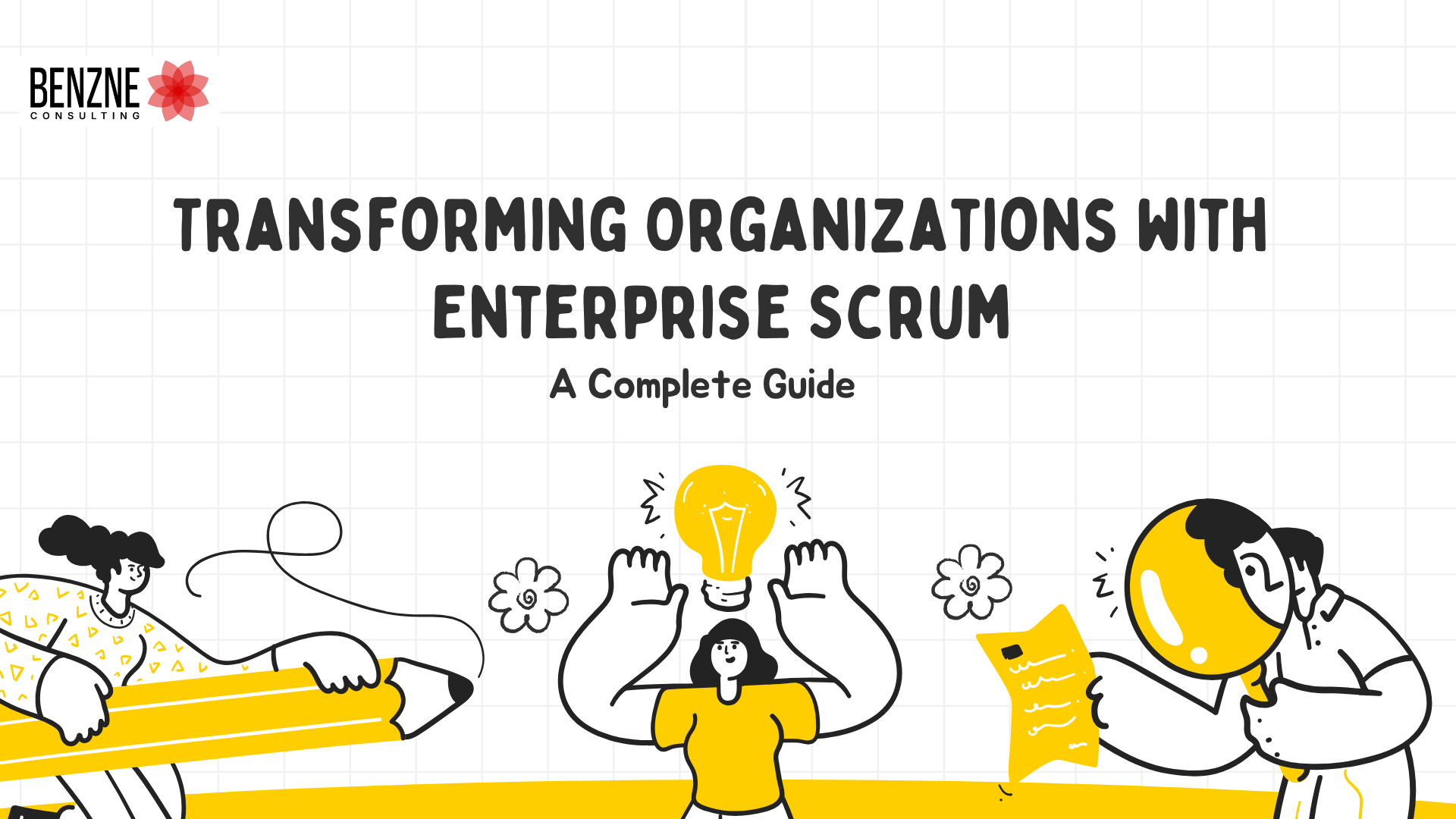Introduction to Enterprise Scrum
In this VUCA world, product development and business execution are no longer just following the same processes and delivering a piece of code. It is all about understanding the customer needs or market demands and staying relevant by taking feedback and pivoting. To do so, teams and products have used one of the most widely used agile frameworks, that is Scrum which helps teams to estimate and plan just enough, develop just enough, take feedback and pivot.
However, when it comes to bringing in the same flavor across the company/organization, they tend to struggle because of a wide variety of constraints like:
- Departments work in different ways
- Lack of company level alignment
- Managing operational dependencies across verticals
What if an organization wants to reach a point where every team from development, HR, Marketing, are all aligned towards a common goal and work towards delivering value to the customers????
Or how do you scale the power of the most widely used framework scrum beyond just teams???
Well of the answers is Enterprise Scrum. Enterprise Scrum provides the structure necessary and guidance to bring in the flavors of scrum to the entire organization.
In this blog, we aim at creating awareness about enterprise scrum and explore various aspects of it like:
- What are the roles in an enterprise scrum framework?
- Advantages of enterprise scrum
- Principles and components of enterprise scrum
- How does enterprise scrum help in business agility?
What is Enterprise Scrum?
Enterprise Scrum is a simple yet powerful framework that is designed to bring in agility across the entire organization. It is a highly configurable/customizable and customer centric framework for achieving business agility. It is a framework that helps business / organizations to adapt quickly to the changing market dimensions, deliver maximum value and increase customer satisfaction.
Enterprise Scrum extends the core principles of single team scrum across multiple teams and departments at enterprise level strategy, operations marketing HR and other departments. Some of the key aspects of enterprise scrum includes:
- Enterprise scrum scales to multiple teams and departments in the organization like HR, Marketing, Finance etc
- It helps all the inter dependent teams to work on a shared goal or strategic goal
- It promotes organizations to apply agile principles across business decisions, strategic planning and portfolio management
Enterprise Scrum has three vital dimensions which are supported by 3 artefacts. Each team/program/portfolio maintains and iterates over these 3 dimensions.
- Configure – For a unit, setting up the key parameters of success. Who are your stakeholders, who are your target customers, products/services supported, metrics, teams
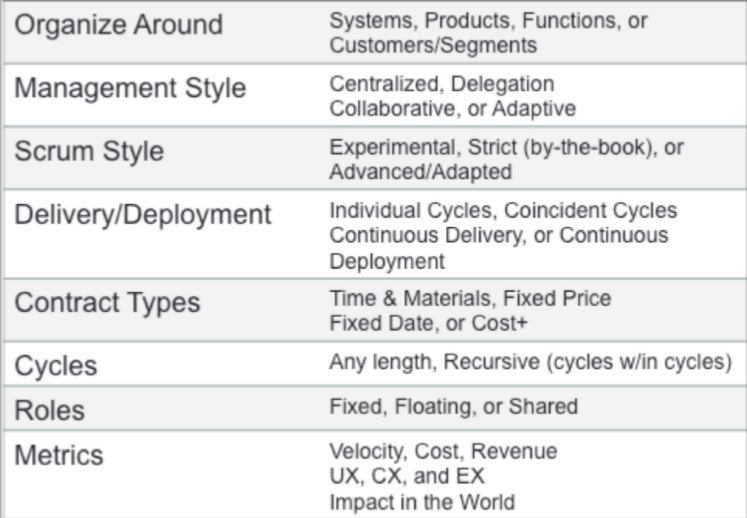
- Visualise – With the information gathered or agreed upon, create your initial canvas. A sample canvas template is as shown below.
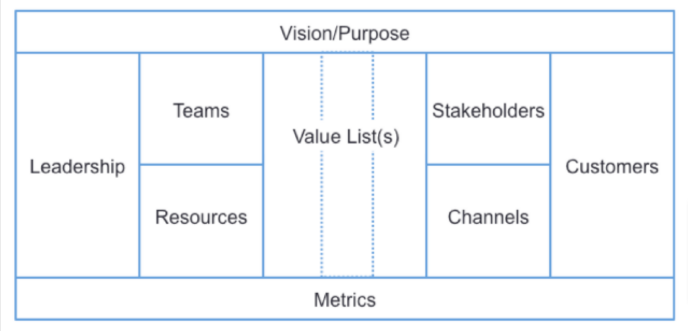
- Iterate – Deliver Value and evolve the process and the canvas.

Benefits of Enterprise Scrum
Enterprise Scrum like the normal scrum framework, when implemented correctly provides a wide range of benefits for the businesses/organizations. Enterprise Scrum basically extends the scrum principles of single team scrum to all other departments within the organization. Some of them include:
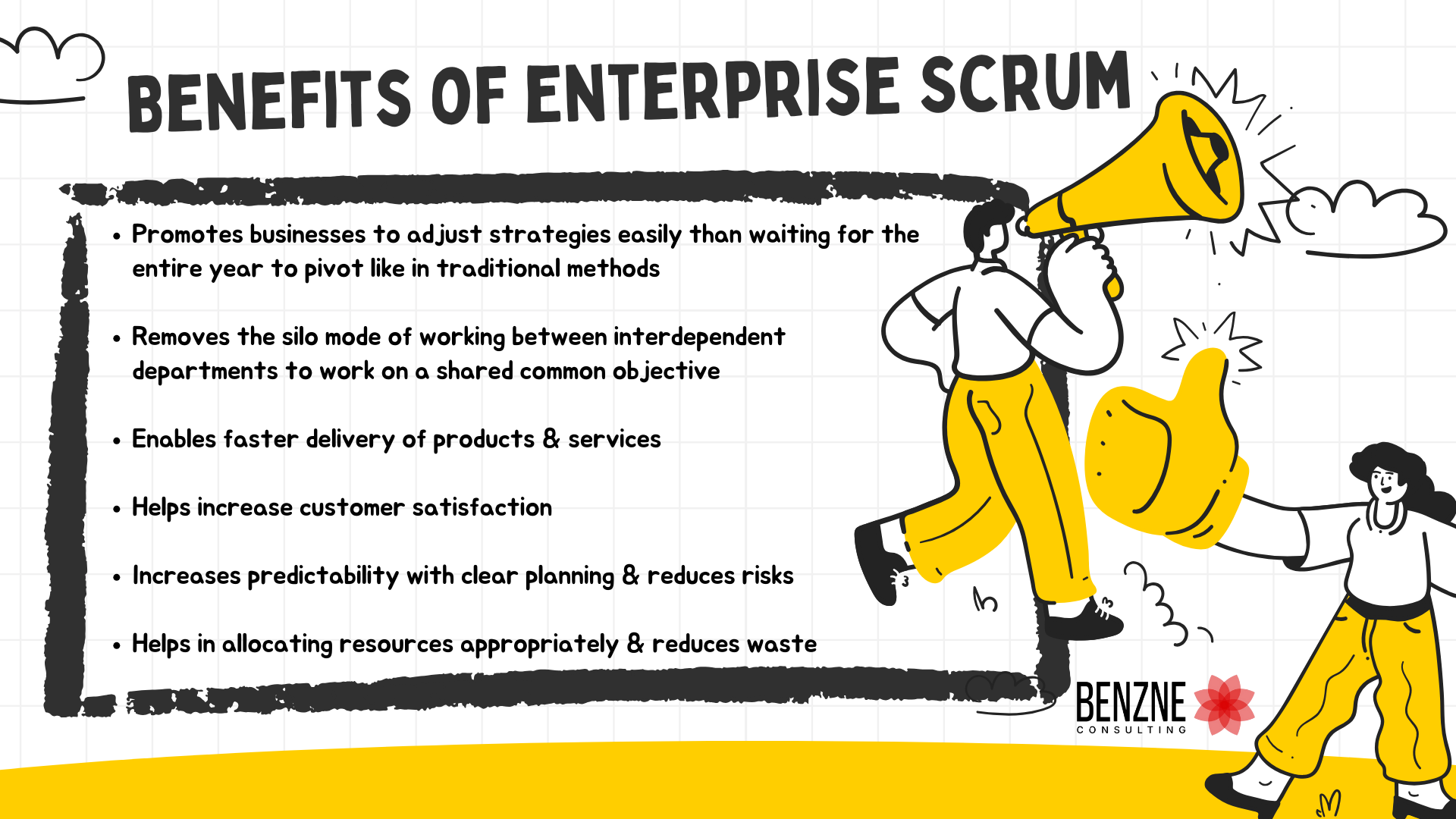
- With ES, organizations can quickly pivot based on changing market needs with iterative planning like changing business priorities, reallocating resources, budget thus making the business more agile
- With its iterative and incremental approach, ES promotes businesses to adjust strategies easily than waiting for the entire year to pivot like in traditional methods
- It removes silo mode of working between interdependent departments to work on a shared common objective
- By breaking down large projects into smaller pieces, it enables faster delivery of products and services
- By delivering value to the customers quickly and continuously, enterprise scrum helps in increasing customer satisfaction
- It increases predictability with clear planning and progress tracking and reduces risks
- With cycles of planning enterprise scrum helps in allocating resources appropriately and reduces waste
Measuring Enterprise Scrum
Any agile transformation or implementation should be outcome driven to measure it’s effectiveness. Agility brings in changes with key business parameters, business drivers, product parameters and also people centric behavior changes. One way to measure the effectiveness and to make informed data driven decisions is to ensure proper metrics are identified. Some of the key metrics to measure the effectiveness of scaling scrum across modern enterprises include,
| Aspect | Key Metrics |
| Business Level | Customer Satisfaction, NPS, Revenue growth, Innovation rate percentage, customer heat maps |
| Operation level | Lead time, cycle time, flow distribution, defect removal efficiency, change failure rate, deployment frequency, mean time to change, predictability measure, Flow distribution |
| Team Level | Velocity, Burndown, Defect created vs resolved, version report, Team health |
What are the Key Challenges in Adopting Enterprise Scrum?
Any transformation journey though it brings results, can be challenging if not handled properly. Enterprise scrum provides a lot of benefits when implemented correctly. Like any other frameworks, it requires the entire organization to change or shift culturally and structurally. A lot of companies go through challenges during the journey some of the common ones include:
- People wanting to stick to the old processes because they are used it to and fear change
- Misalignment or politics at leadership level and lack of buy in
- Lack of commitment and bandwidth with people who are leading the transformation
- No awareness of the purpose of transformation
- Pushing the transformation into the teams without understanding their problems
- No proper metrics and information radiators
- No support from existing systems
- Lack of frameworks to handle distributed teams
Key Principles of Enterprise Scrum
Enterprise Scrum is not just a scaled up version of normal scrum. It is a set of principles that is designed to help companies achieve agility at scale. While these principles serve as the foundation of the framework, practices that bring in the principles within the teams can vary or be customised as per the system. Below are the key principles of enterprise scrum:
- Customer Centric value Delivery – Deliver value to the customer early and often
- Crossfunctional Collaboration – Bring in all the departments together and break the silos
- Incremental and Iterative – Plan just enough and deliver to get continuous feedback and pivot based on the need
- Transparency – Maintain clear communication across the organization
- Autonomy – Create teams and pods who can take their decisions and empower them
- Continuous Improvement – Continuously look at what is working and what needs to be improved and close the gaps
- Simple Scalability – Create processes and structures that helps scale the practices without much complexity
- Outcome Vs Output – Measure success based on key business outcome like OKRs etc rather than just running towards a metric like velocity, amount of work done etc
How Enterprise Scrum Supports Business Agility?
Staying relevant in today’s uncertain and fast world is a vital struggle for any business. Organizations need to keep their customers satisfied, continuously adhere to changing market dynamics and still deliver value. Enterprise Scrum as a framework directly helps organizations in achieving their goals by:
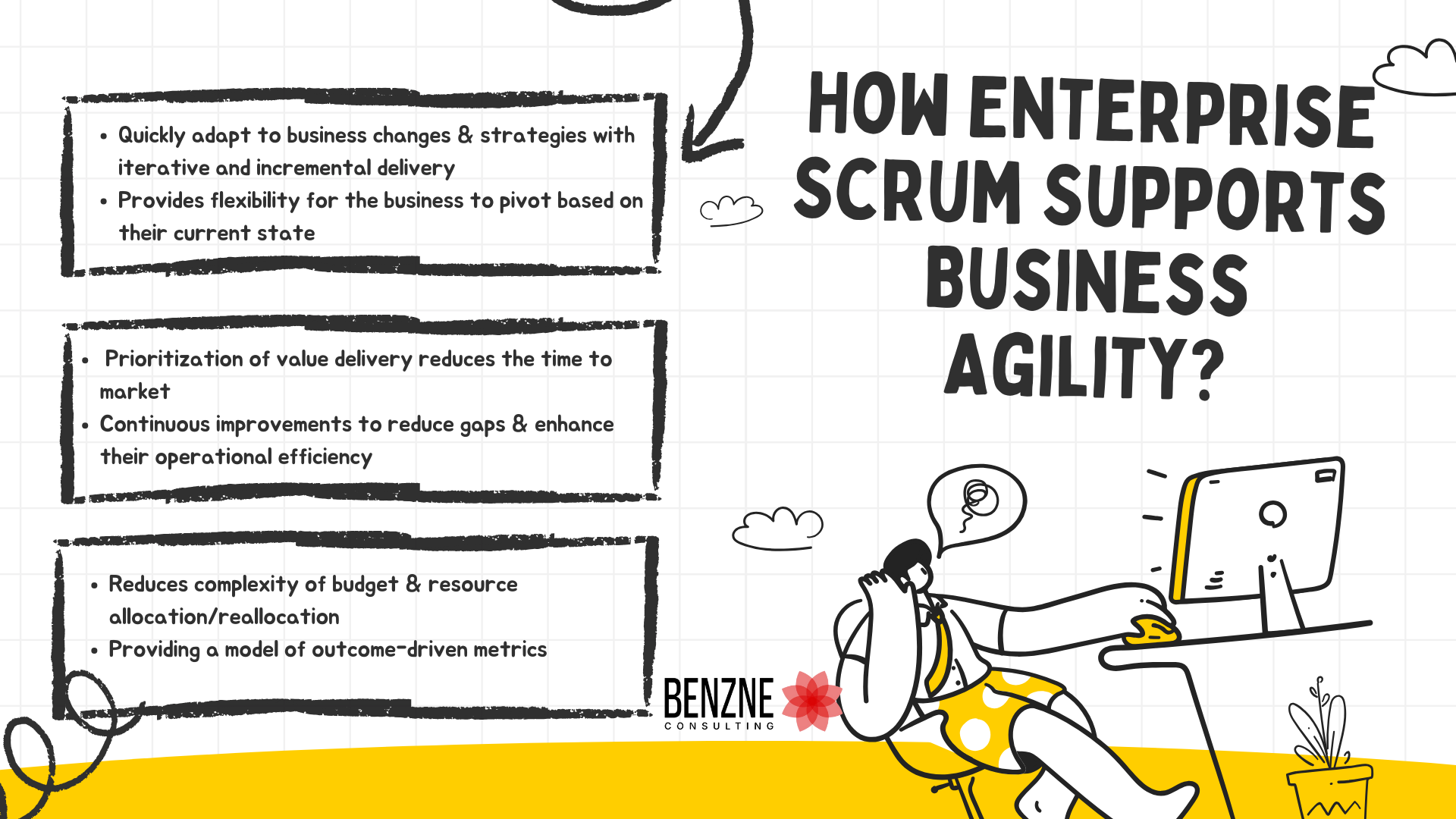
- Quickly adapt to business changes and strategies with iterative and incremental delivery
- Staying ahead with continuous feedback loops with retros and reviews
- Provides flexibility for the business to pivot based on their current state
- Alignment of all the departments to a common shared goal
- Prioritisation of value delivery reduces the time to market
- Continuous improvements to reduce gaps and enhance their operational efficiency
- Reduces complexity of budget and resource allocation/reallocation
- Providing a model of metrics which are outcome driven
Enterprise Scrum Roles and Responsibilities
While the basic foundation of enterprise scrum is of traditional scrum in terms of structure and the roles, when you zoom out, it requires a few additional roles with the same ideology. And these additional roles still cater to the ideology or business strategy, execution and collaboration. Below are the roles which come into Enterprise Scrum preview:
● Enterprise Product Owner (EPO)
- A product or business person who sets the direction to the entire organization. Overall vision strategy, business objectives and strategy is a pure accountability of an EPO. While some of the responsibilities include,
- Creating and maintaining the business objectives at the business level
- Ensure alignment with product roadmaps and the strategy
- Help prioritise value delivery within the teams
- Translation of objectives to portfolios and programs
- Closely collaborate with enterprise architects, business owners, and customers
● Enterprise Scrum Master (ESM)
- A people and process servant leader who maintains and fosters agility across departments, portfolios and teams. An organization coach who ensures maximum efficiency is derived from the execution stand point. Some of the responsibilities include,
- Overall agility across the organisation
- Coach and mentor leadership, scrum masters and teams
- Remove impediments to make the flow of value efficient
- Strategise the transformation and scaling
- Drive company level inspect and adoption
● Agile Leadership
- A cohort of servant leaders/practitioners who drive the transformation across the enterprise. They are a set of agile coaches, leaders who play a vital role in supporting the agile vision within an organisation. Some of their responsibilities include,
- Roadmapping the transformation
- Getting leadership buy in
- Providing awareness training
- Driving the transformation
- Solving team and business problems in terms of process
- Coaching and mentoring teams and programs
- Support agile metrics and governance
● Stakeholders
- Sponsors of initiatives like agile transformation and key decision makers who provide high level business direction and help enterprise scrum align with key business objectives and strategies. Some of their responsibilities include,
- Provide and enable a clear path to support initiatives
- Ensure enterprise scrum meets their business goals
- Continuously monitor and provide feedback on enterprise level initiatives
- Manage and make high level funding and take decisions on prioritization
● Development Teams
- Actual cross functional doers who convert the requirements into a working software or a value delivery increment. Their responsibilities include,
- Design, develop test and deliver work with quality
- Use Agile estimation techniques to plan relative sizes of work items
- Manage dependencies by collaborating with other teams
- Contribute in enterprise scrum events like planning and reviews
- Continuously improve by tracking metrics
● Enterprise Agile Coach
- Sets the direction and helps the organization in adopting and scaling scrum principles across the whole of the organization. Some of the responsibilities include,
- Educating leadership, teams and stakeholders in agile best practices
- Roadmapping the transformation
- Getting leadership buy in
- Coach teams on scrum maturity and mindset
- Set direction to the agile leadership in large scale agile transformation and strategise the initiatives with stakeholders
Core Components of Enterprise Scrum
Enterprise Scrum is a powerful framework for any business/organization to attain business agility. It provides the structure and practices needed to scale agility at the enterprise level through the core competencies. These competencies, when brought together in the organization’s operations, can promote a system that is collaborative and delivers value frequently and continuously.
● Enterprise-Level Backlog Management
- List of to do’s at the business level which helps the organization achieve their goals. Could be a list of initiatives, product or even services. Below are a list of work items that can be usually seen in enterprise level backlog,
- High level vision that gives the direction of what we are building and for whom
- Strategic themes that breaks the vision into actionable focus areas
- A prioritized list of epics or large initiatives that align with the strategic themes
- Enterprise sprint backlog items that the whole organization is working on for a particular cycle
● Coordinated Sprint Planning Across Teams
- Every sprint / cycle starts with a sprint planning meeting just like traditional scrum. Basically the idea is to decide the next increment. A generic cycle planning / sprint planning which is coordinated could look like,
- Understand the increment from a portfolio level which includes multiple departments and teams
- Teams to pick work from the list and perform their individual team planning
- All teams to finally present their team level commitments
- Overall commitment to be stitched together to understand the cycle increment
● Role Adaptations in Enterprise Scrum
- As mentioned above in the roles section, Enterprise Scrum requires a few additional roles with the same ideology. And these additional roles still cater to the ideology or business strategy, execution and collaboration and are required to ensure alignment, coordination and leadership at that level. Here are a few points on how normal scrum roles adapt to enterprise scrum,
- A team product owner manages the product/team backlog while Enterprise product owner manages the enterprise backlog
- Team coach/scrum master manages agility at the team level while enterprise scrum master manages agility at the business level
- Individuals in the development team work closely with a shared goal in a sprint, while in enterprise scrum, teams work with multiple other teams on a shared goals
● Cross-Team Communication and Transparency
- When there are multiple teams involved, there need to be certain models of communication and dependency management. Here are a few events which aids cross team communication
- Scrum of Scrums – A daily/weekly meeting of scrum masters from different teams to discuss progress, dependencies and risks
- Portfolio Review – A cadence based meeting to review the overall progress of the portfolio to make adjustments to the roadmap
● Enterprise-Wide Agile Metrics and Reporting
- A common set of metrics derived based on the business needs and context. The intention here is to ensure all the teams speak the same language in terms of metrics to understand the gaps and make improvements.
- Business Level Metrics – Customer Satisfaction, NPS, Revenue growth, Innovation rate percentage, customer heat maps
- Operational Level Metrics – Lead time, cycle time, flow distribution, defect removal efficiency, change failure rate, deployment frequency, mean time to change, predictability measure, Flow distribution
- Portfolio level metrics – Portfolio velocity, flow distribution, predictability measure
- Team level Metrics – Velocity, Burndown, Defect created vs resolved, version report, Team health
● Enterprise Sprint Reviews and Retrospectives
- Sprint reviews and retrospectives have more importance in enterprise scrum as there are multiple teams involved and help them align and validate their team outcome with the shared goals.
- Enterprise Sprint review – Usually focuses on the integrated product and not just individual team outputs. Teams present their increment and showcase the alignment with the goal. Stakeholders validate the same and provide feedback
- Enterprise Retrospective – The intention is to reflect on the past sprint and understand and identify areas of improvement to make the next cycle experience much better. Teams can use any of their preferred template for their retrospective
● Scaling Frameworks Integration
- One of the most important part of enterprise scrum is the synchronization of teams. This can be achieved using scaled agile frameworks like,
- Scaled Agile Framework – The most used scaled framework to bring alignment between strategy, execution and governance at scale
- Large Scale Scrum (LeSS) – Use practices and components of LeSS for huge product groups in case you want to reduce overhead and want to keep it simple
- Scrum @ Scale – When you want to focus on dependency management between large product teams effectively by scaling daily scrum to coordinate
● Leadership Involvement and Support
- For enterprise scrum or any transformation to be successful, leadership buy-in is a very vital point. Leaders are supposed to be active and lead the change from the front, set the direction, remove blockers and impediments and empower their people. Without their buy in and support, even the best teams would struggle to be successful. The intention here is for the leadership to lead by example rather than just giving orders.
● Tooling and Technology for Enterprise Scrum
- Enterprise Scrum, like any other scaling scrum across modern enterprises, requires the right set of tools and technologies to support transparency, collaboration and make the process efficient. A right tool can streamline workflows, improve communication and provide visibility into the right set of information or date. Here are a few tools which can be used in the transformation:
- Agile Project Management Tools – Jira, Asana, Azure DevOps, Trello, Businessmap
- Collaboration tools – Mural, Miro, Mind maps, confluence
- Communication tools – Microsoft teams, zoon, Google meet, Slack
Key Practices in Enterprise Scrum
As mentioned above, enterprise scrum is built on certain principles. However, the success of it depends on the discipline of following certain practices. Practices are the doable action items to achieve a principle. Practices enable teams to collaborate, deliver value and adapt to change. Below are a a few basic key practices in enterprise scrum:
● Effective Communication and Coordination Across Teams
- While traditional scrum teams have ceremonies to promote communication, there are a few practices that help team of teams to collaborate and communicate effectively,
- Unified and transparent communication – Use centralised dashboards in tools like Jira, Azure DevOps as the single source of truth. Promote open communication channels like zoom, microsoft teams, google teams and slack
- Inter team communication – Use events like Scrum of Scrums which is a daily/weekly meeting of scrum masters from different teams to discuss progress, dependencies and risks and Portfolio Review a cadence based meeting to review the overall progress of the portfolio to make adjustments to the roadmap
- Dependency Management – Visualise dependencies with the help of tools like roadmap/plan view in Jira
- Risk Communication – Note all the risks in confluence or on jira using ROAM framework
- Collaboration and brainstorming – Use common collaboration tools Mural, Miro etc
● Prioritizing Work at the Enterprise Level
- One of the most important principles of enterprise scrum is to deliver value continuously. This requires prioritization of work at the enterprise level. Products or initiatives which the teams work on should be aligned with the organisation’s business objectives. Here are a few points on how can you prioritise work at enterprise level
- First step is to define the organization vision and strategic objectives
- Next step is to create a unified and centralised backlog that aligns with the objectives
- Use frameworks like WSJF, MOSCOW and KANO to rank the work based on the value and urgency
- Prepare a roadmap at the enterprise level to ensure there is a concrete direction for the teams
● Delivering Continuous Value
- Enterprise Scrum like traditional scrum promotes incremental and iterative value delivery. This helps organizations to deliver value continuously versus delivery at the end of the project. Here are a few key practices that can help teams deliver value continuously,
- Use product backlog to align with the business goals and prioritise accordingly
- Plan just enough , small releases of increment to gather feedback
- Create a feedback loop mechanism like retrospectives, reviews to collect feedback and work on fixing them
- Use ceremonies like portfolio sync, scrum of scrums to manage change and incorporate changing priorities
How Can Benzne Consulting Help With Enterprise Scrum Coach?
Benzene is an outcome driven agile scrum consulting firm with a proven track record of successful turnkey agile transformation across domains and industries. We provide custom, tailored approaches to solve organisation problems like execution certainty, siloed mode of working, transparency, lack of predictability, streamlining workflows and processes, scaling agile adoption, reduced time to market and increased customer satisfaction leveraging our indepth agile transformation experience and expert agile practitioners. Here is how our typical transformation or consulting journey looks like with what we offer at each stage:
- Pre Game: First stage of the transformation where we,
- Do an As-Is assessment to understand the current team’s maturity and practices
- Create a tailored customized roadmap to align with the problem statement or goals
- Provide training and awareness workshops on the framework and practices needed
- Educate and certify the roles needed in the framework
- Game: Second stage of the transformation where our expert agile practitioners,
- Design and recommend framework implementation based on need and the system
- Work closely with a few pilot teams and leadership to guide them through the transformation process
- Provide continuous support, observe and provide feedback, and guidance on implementing the practices and by resolving challenges
- Cross pollinate the success story to multiple departments, portfolios and programs
- Post Game: The third and the last stage of the transformation where,
- We create internal center of excellence for sustenance of the transformation
- Create adequate knowledge base with playbooks, guides and manuals
Conclusion
Enterprise Scrum is a powerful framework that helps organizations to scale their scrum benefits at the business level. The idea is to align multiple teams / programs / portfolios to a common shared goal which is also a business objective. By integrating competencies like enterprise level backlog management, coordinated sprint planning and review, cross team communication, organisations can reap the benefits of enterprise scrum like faster time to market, reduced feedback loop and continuous value delivery.
When there are multiple teams involved, it becomes difficult to bring in collaboration and transparency between them, however enterprise scrum helps overcome them with events/ceremonies like Scrum of Scrums and Portfolio/product sync.
Enterprise Scrum master, Enterprise product owner, Enterprise agile coach and other roles help bring alignment between business and teams and help them coordinate, prioritise work based on the business objectives set and enable them to go hand in hand. Like any other transformation enterprise scrum also comes with a lot of challenges which can be addressed with leadership support, scaling frameworks which are suited. Also, choosing the right tools become vital in any transformation or implementation, these tools help bring in transparency and in deriving the right set of metrics to help organizations in continuous improvement in their journey of business agility.
With this, our blog on “Enterprise Scrum” comes to an end. We sincerely hope this has helped our readers get some clarity around it. We would be glad to discuss your unique agility adoption bottlenecks at Benzne Agile Transformation consulting and support your agile journey. Please write to us at “consult@benzne.com” for any further feedback or recommendations or in case you are looking for external coaching support.
Frequently Asked Questions About Transforming Organizations with Enterprise Scrum
1. What tools are essential for implementing Enterprise Scrum effectively?
Enterprise Scrum, like any other scaling scrum across modern enterprises, require the right set of tools and technologies to support transparency, collaboration and make the process efficient. A right tool can streamline workflows, improve communication and provide visibility into the right set of information or date. Here are a few tools which can be used in the transformation,
- Agile Project Management Tools – Jira, Asana, Azure DevOps, Trello, Businessmap
- Collaboration tools – Mural, Miro, Mind maps, confluence
- Communication tools – Microsoft teams, zoon, Google meet, Slack
2. Can Enterprise Scrum be applied in non-software development contexts?
Yes. Enterprise scrum and its principles and practices can be used in a wide range of industries domains beyond software development. The basic foundation of enterprise scrum is scaling agility across the business for continuous value delivery, collaboration between teams and alignment between company objectives and team’s work which is not only restricted to software development.
3. How do you handle resistance to change when implementing Enterprise Scrum?
Resistance to change can come with a lot of underlying fear and complacency. It is important to first understand what the root cause for the resistance is. Here are some tips to overcome it.
- First step is to let everyone know the WHY part of adopting enterprise scrum
- Next is to provide trainings and workshops to bring in the awareness which rescues the fear of unknown
- Create success stories which will help others visualise how it benefits them
- Be a servant leader. Remove roadblocks for individuals and teams for a smooth transformation
4. How is success measured in an Enterprise Scrum framework?
Any agile transformation or implementation should be outcome driven to measure it’s effectiveness. Agility brings in changes with key business parameters, business drivers, product parameters and also people centric behavior changes. One way to measure the effectiveness and to make informed data driven decisions is to ensure proper metrics are identified. Some of the key metrics to measure the effectiveness of scaling scrum across modern enterprises include,
- Business Level Metrics – Customer Satisfaction, NPS, Revenue growth, Innovation rate percentage, customer heat maps
- Operation level Metrics – Lead time, cycle time, flow distribution, defect removal efficiency, change failure rate, deployment frequency, mean time to change, predictability measure, Flow distribution
- Team Level – Velocity, Burndown, Defect created vs resolved, version report, Team health
- Portfolio level metrics – Portfolio velocity, flow distribution, predictability measure
5. What is the role of culture in scaling Scrum to the enterprise level?
Scaling scrum to enterprise level is not just about implementing the process. It is about transforming how people think, see and behave and it plays a very crucial tole in any transformation. Below are a few cultural shift enterprise scrum promotes,
- Moving away from one person / top to down decision making to empowering teams to take accountability of their work
- Shift from silos departmental ways of working to cross functional team of teams
- Move towards creating an environment where failure is alright
- Moving towards the mindset of accepting changes rather than sticking to a concrete plan
- Creating an environment where team success is more important than individual heroism

